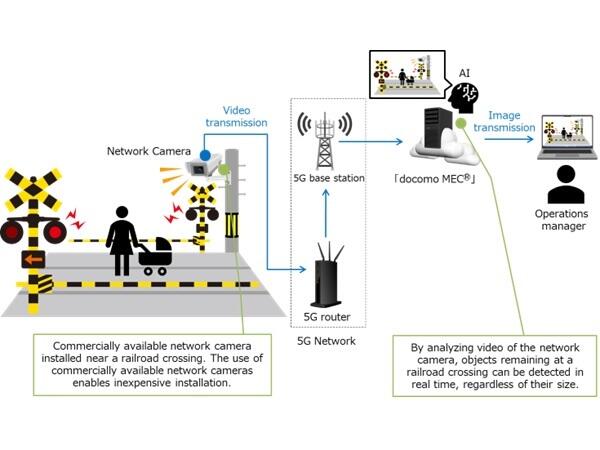Kanto Railway, Koshida Corporation, Yashima, and NTT Communications (NTT Com) began their verification test on September 1 at the Ebihara Railroad Crossing on Kanto Railway Joso Line. This crossing is located between Moriya Station and Shin-Moriya Station in Moriya City, Ibaraki Prefecture. The purpose of this test is to prevent railroad crossing accidents by utilizing the 'AI System to Detect Objects Remaining at Railroad Crossings' (patent pending). This system can detect objects remaining at railroad crossings with precision and in real time, regardless of their sizes. The tests will continue until March 31 of next year.
Railroad crossing accidents account for about 40% of all railroad traffic accidents. In the fiscal year 2021, there were 217 incidents. Moreover, 42.9% of railroad crossing accidents were caused by pedestrians who were unable to cross in time (the statistics were taken from Information Concerning Safety in Railroad Traffic, FY2021, Ministry of Land, Infrastructure, Transport and Tourism (MLIT)).

Provided by Koshida Corporation
To prevent such accidents, obstacle detecting devices are typically installed at railroad crossings to detect the objects remaining there. They have the ability to accurately detect larger objects such as cars. However, there are still unsolved issues. It is believed that significant enhancements are needed to detect smaller objects, such as bicycles, strollers, wheelchairs, dollies, and the persons handling such objects.
In light of this, the verification test entails the utilization of the 'AI System to Detect Objects Remaining at Railroad Crossings,' which uses the 5G network and AI. The aim is to enhance the accuracy of detecting smaller objects and thereby prevent railroad crossing accidents. To detect objects, this system uses network cameras that are available on the market and are installed near railroad crossings. The video data from these cameras are transferred over the 5G network to the 'Docomo MEC' service, where it is processed on a server and stored somewhere close to the user (MEC stands for Multi-access Edge Computing).
The system learns the characteristics of the transferred video as training data. It uses variational autoencoder (VAE), a model that can generate similar images, and AI to find background differences. This method helps detect moving objects. As a result of these technologies, the system can accurately detect the objects remaining at a railroad crossing in real time, regardless of their sizes. Once an object is detected, the system sends an alert to the facility administrator. In addition, the captured video images are transferred to 'Docomo MEC,' where they are stored for a specific period of time. This allows the cameras to also function as surveillance cameras, enabling remote users to view the sites.
In this verification test, the accuracy of detecting not only cars but also smaller objects such as bicycles, strollers, wheelchairs, dollies, and the persons handling them are verified. Furthermore, the accuracy of detecting obstacles with other currently available devices is compared. Kanto Railway provided the testing location, while Koshida developed and provided the system, including the AI involved in the system. Yashima provided Kanto Railway with the system idea, while NTT Com provided the 5G network along with 'Docomo MEC.'
The four companies will acquire the results from this verification test, which will last up to seven months. They will then verify the effectiveness of the system. They will simultaneously modify the system to alert train drivers approaching a crossing whenever any remaining object is detected at that crossing. After that, they will make proposals for introducing the system to railroad companies. Furthermore, they will utilize the technology in the system to detect intruding birds and animals on railroads, people falling off the platforms, foreign objects on railroad station premises, and more. Thus, they are committed to contributing to the smooth operation of railroad traffic and ensuring safety at railroad station premises.
This article has been translated by JST with permission from The Science News Ltd. (https://sci-news.co.jp/). Unauthorized reproduction of the article and photographs is prohibited.




